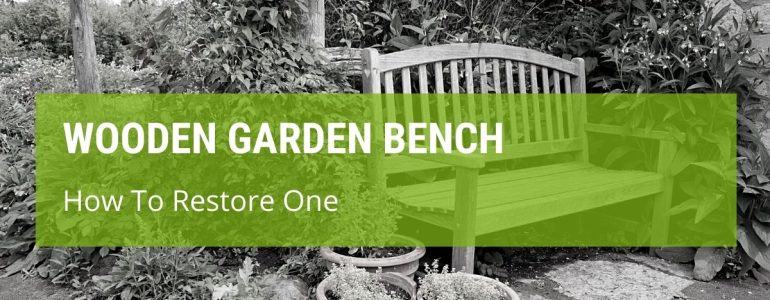It’s lovely to have a place to sit in your garden and enjoy the view, isn’t it? But what do you do when your favourite seat starts to fall apart? You learn how to restore a wooden garden bench, that’s what!
Restoring a seat is not as hard as you might think, and you almost certainly won’t need any fancy equipment beyond a few tools!
How Do You Restore An Old Bench Seat?
- Start by giving it a good clean. Scrub away any old paint, and clean off algae, mould and dirt.
- Any nuts and bolts will probably be jammed, so release them (WD40 works a treat!)
- Any wooden slats that have rotted will need replacing, so that the bench stays strong enough to hold weight.
- Give the new slats a good sanding so that there are no splinters, and ensure that you screw or bolt them in well.
- Applying a layer of preservative will help the wood to stay stronger for longer, and should also ensure that it stands up to the weather.
- Scrub any metalwork with a wire brush, to ensure that it not only looks nice, but to make sure there is no rust.
- Repaint the metalwork your chosen colour – you should ensure that this is a paint designed for metal, and that it is weatherproof.
This article takes you through the essential maintenance you should do on your garden furniture, to keep it looking its best.
Can I Restore Rotting Wood?
Although replacing rotten wood is the best idea, there are also some ways that you can restore it, using a few different fillers.
- You will need to first remove the rotted section from the wood you are trying to restore.
- Make sure that you have cleared a small section either side of where the rot was, to ensure it doesn’t spread.
- Using a polyester filler or wood-patch, fill in the area where you have removed the rot.
- Allow the filler to dry and harden completely, then paint it the same colour as the wood to make it all look the same.
- Test it before you sit on it, to make sure you aren’t going to fall through!
Replacing any rotten wood is easier, safer and probably quicker than going down the filler route – but if it is just a small section of rot then this method can work really well.
How Do You Restore A Wooden Cast Iron Bench?
- Start by dismantling the entire bench. The metalwork may be rusted together, so you will need some WD40 – and some elbow grease!
- Sand off each of the wooden slats using a belt sander. This will help you decide whether there are any that may need replacing entirely.
- Apply a weatherproofing treatment to all the wood work, to help it stand up to the weather in the future.
- Wearing protective equipment, remove the old paint and rust from the metal work. You can use a wire brush or an angle grinder for this.
- Dust off all the metal particles from the metal work using a soft, clean cloth, to prevent any lumps and bumps when you paint it.
- Using a rust-resistant paint, paint the metal work of your bench, then leave it to dry for at least 24 hours.
- Reassemble the bench, taking particular care to tighten nuts, bolts and screws so that the bench is strong and sturdy.
This video will take you through the steps to restoring your cast iron wooden bench:
How Do I Strengthen My Garden Bench?
You love your garden bench, you don’t want to replace it – but it is getting weaker in its old age. How do you make it strong again?
Adding strips of metal to the underside of the bench will help enormously, as this will reinforce the sagging wood.
Placing a third leg to the middle of the bench can also help to hold up timber that is getting weaker with age.
You can also replace the seat entirely, by replacing the old timber with new slats. This is a longer term fix, and although it will take more effort, this will help your bench last for a good few more years.
Can You Bring Weathered Wood Back To Life?
Wood, like the rest of us, can start to look a little grey and haggard if it spends too much time in the sun.
As long as it is still structurally sound, however, you don’t have to replace it – you can get it back to its former glory!
Boiled linseed oil is your secret weapon for reviving old, tired wood. It’s easy to get hold of, relatively cheap, and it will give your old wood a new lease of life.
- Start by sanding the wood lightly, to get rid of any little splinters and get the wood ready for oiling.
- Mix boiled linseed oil and turpentine in a ratio of 50/50.
- Apply this mixture using a brush or an old rag – and we’re talking liberally. Coat the mixture on so that it really penetrates the wood.
- Give the wood a quick wipe with a clean cloth if it still looks shiny after a couple of minutes; it should soak right into the grain.
- Leave it to dry for 24-48 hours, and don’t be tempted to add a second coat too quickly as the oil can build up too much and cause problems if you decide to paint the wood.
- After 48 hours, you can prime and paint the wood, or you can leave it with a natural finish.
- If you are going with the linseed oil finish, you will need to add a few more coats over the course of a week or so – waiting a day or two in between coats.
Final Words
Once you have learned how to restore a wooden garden bench, you can enjoy your favourite seat for years to come – safe in the knowledge that it was all your own work!





